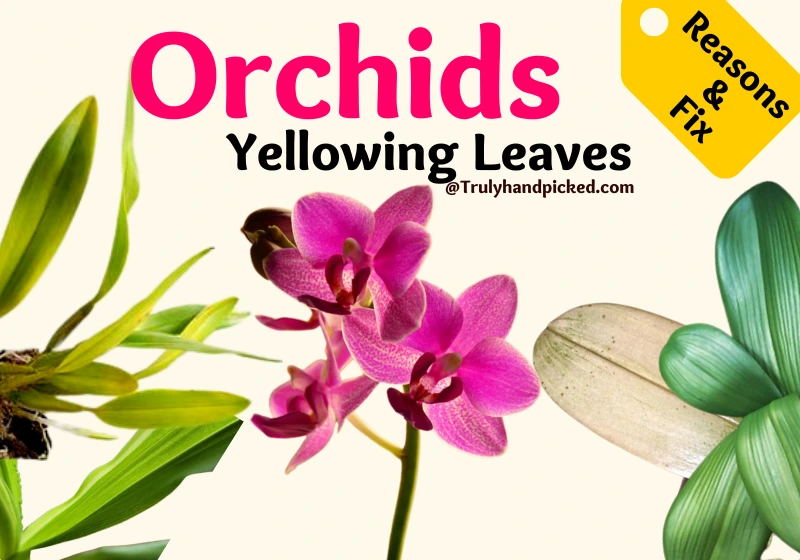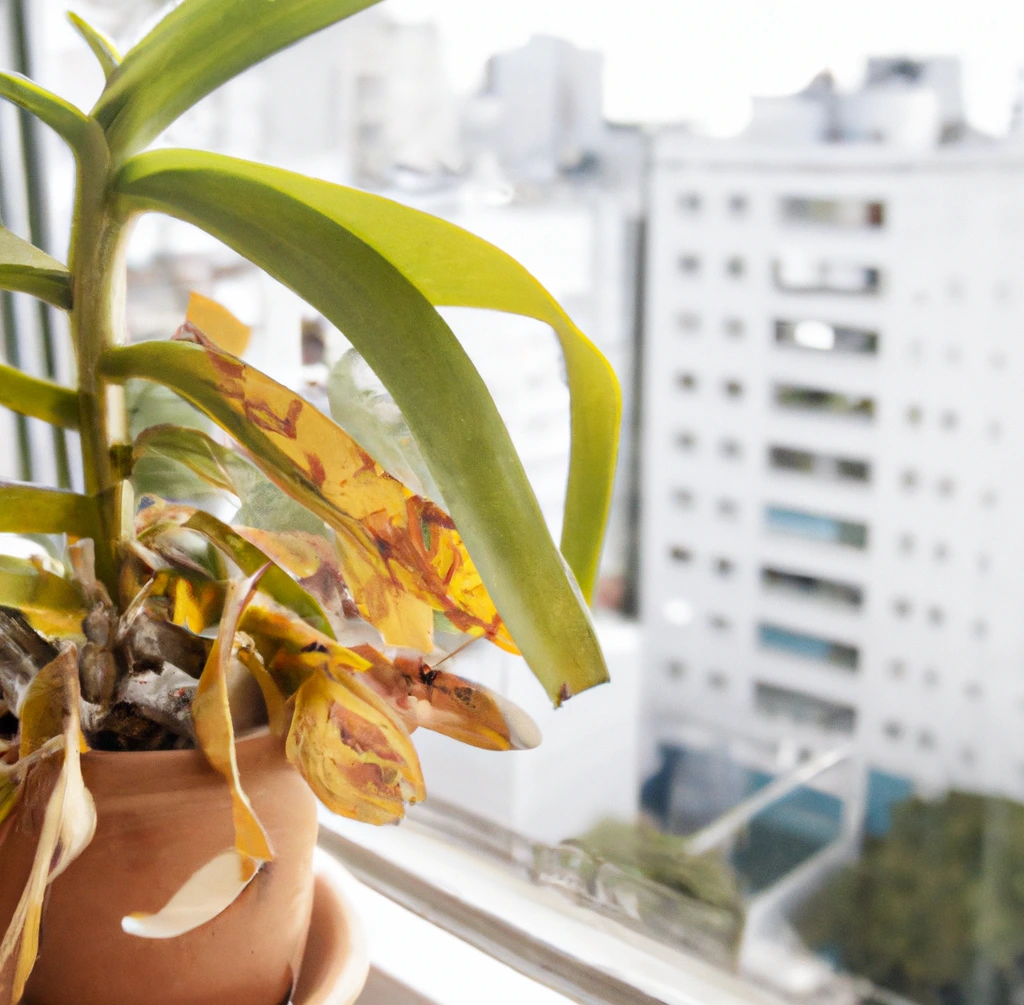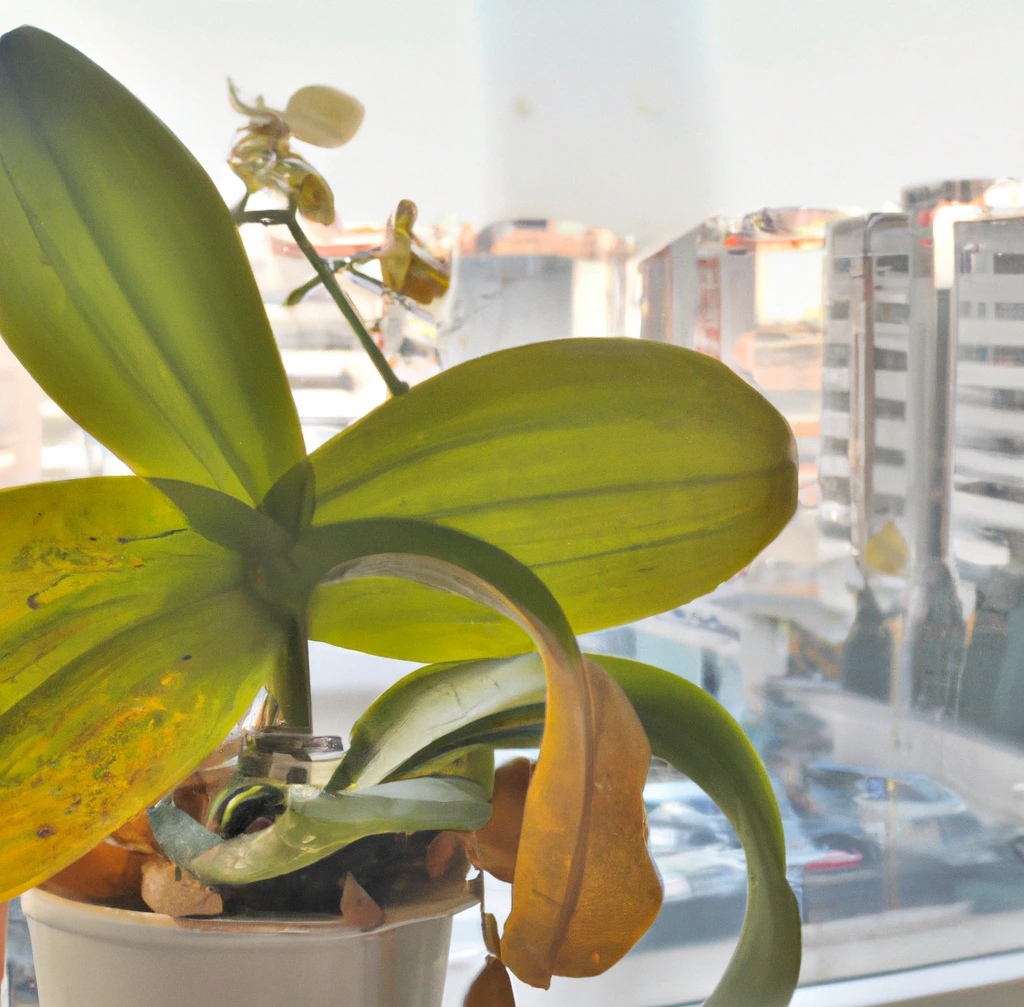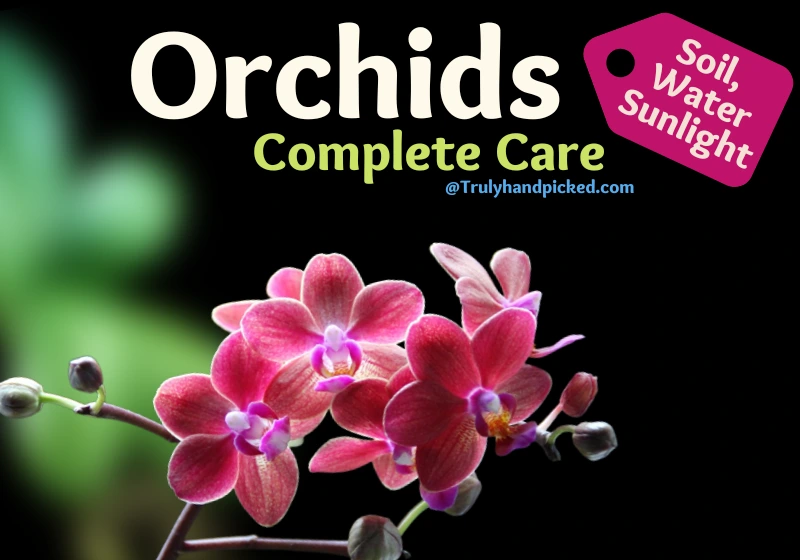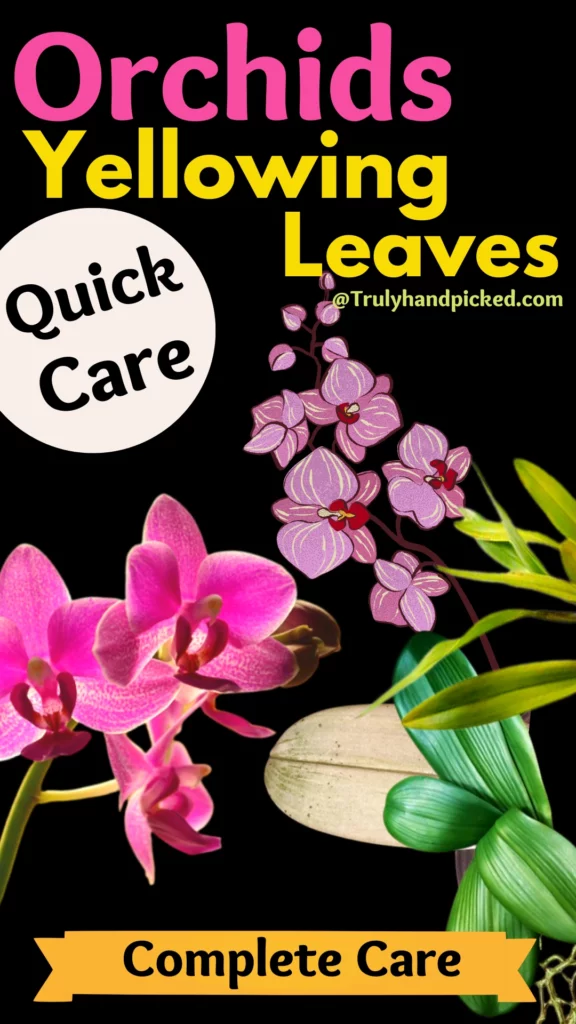The orchids incorporate almost 28,000 species dispersed in about 763 genera. Each species of orchid grow attractive and colorful flowers with a pleasant fragrance.
Orchid Leaves Turning Yellow -In Short: Overwatering, light exposure, and Change of place are the common reasons for yellowing leaves.
If your orchid plant is near dying: Avoid trimming or pulling off the yellow leaves from your orchid plants. Check for root rot, remove mushy roots, and repot your plant to a sterile planter with a fresh potting mix. Make changes to your watering schedule to keep the soil moist enough but not soggy.
It is up to you what species you are going to cultivate in your garden. However, each option will delight you at the end of the growing session with just a few basic needs!
You can cultivate an orchid plant in an open outdoor garden under direct sunlight or carefully as a houseplant. Both processes will be unproblematic in every manner.
Difference Between Abnormal and Normal Yellowing
Orchids, like many plants, can naturally shed older leaves as part of their growth cycle. However, it’s essential to differentiate between normal leaf shedding and leaves turning yellow due to underlying issues.
Normal Leaf Shedding:
- Location: Normal leaf shedding typically starts from the bottom of the plant and progresses upward. This is because older leaves are naturally shed to make way for new growth.
- Pattern: Leaves that are naturally shedding may turn yellow from the tip or edges inward. They often maintain their structural integrity and remain firmly attached to the stem.
- Frequency: Occasional yellowing and leaf drop are normal during the growing season as orchids renew their foliage. This process is gradual and doesn’t typically affect multiple leaves at once.
- Symmetry: The process is often symmetrical, meaning that if one old leaf is shedding, the corresponding leaf on the opposite side should be similarly affected.
- Leaf Condition: Leaves undergoing natural shedding may turn yellow first before eventually drying up and falling off. These leaves tend to wither uniformly, with no unusual spots or discoloration.
Abnormal Yellowing:
- Location: Abnormal yellowing can occur on any part of the plant, not just the older leaves. It may affect leaves throughout the plant, including the newer ones.
- Pattern: Leaves affected by stress or disease may turn entirely yellow or brown, including the central part of the leaf. They may become droopy, wrinkled, or show signs of damage.
- Speed: Abnormal yellowing usually occurs more rapidly than normal leaf shedding. Leaves may turn yellow and wilt within a short period.
- Symmetry: Yellowing leaves due to problems may not follow a symmetrical pattern. One side of the plant may be affected more than the other.
- Leaf Condition: Yellowing leaves may show additional signs of stress, such as spotting, browning, or unusual discoloration. The leaves may feel soft or mushy to the touch, particularly if root rot is the cause.
Orchid Plants Quick Care Tips
- Soil: Loose, slightly acidic soil, rich in perlite and organic fertilizer and the mix is well-draining
- Water: Twice a week in normal weather and once a week during frosts
- Fertilizer: One in a month with a high-nutrient organic fertilizer in diluted form
- Sun Exposure: Sun with partial shade to full sun (for some specific species)
- Climate: Warm temperature with 80-90% of humidity
- Hardiness Zones: 6 to 11 (depending on the selected species)
Orchids Yellowing Leaves – Pictures
My Orchid Leaves Are Turning Yellow – Reasons and Fix
It is not rare to find that your orchid leaves are yellowing. However, it indicates that you should be a little more attentive to the care procedure of your plant.
There are always some specific reasons that work behind this common orchid plant problem. You just need to treat those problems well to solve the issues permanently.
Related: Why orchids are not blooming – how to fix
Reasons for Yellowing Leaves:
- Watering issues like overwatering or underwatering
- Root rot due to too much moisture buildup in the soil due to poor drainage
- Due to direct scorching heat for keeping your plant under direct sunlight for long (temperature more than 80 degrees F)
- Improper climate like keeping your plat in a high-humid place in a colder temperature (less than 50-55 degrees F)
- Repotting shock when you repot your orchid plant more frequently
- Season changes that happen due to temperature fluctuation
- Lack of nutrients due to irregular and inadequate fertilization
- And for the aging process, as the leaves and the plant become older, it brings this inevitable outcome of an orchid plant eventually.
Related: Why my African violets are turning yellow
Recap and Solutions for Yellowing Leaves
Addressing the underlying causes of yellowing orchid leaves requires careful attention to various factors, including light, watering, pest control, and environmental conditions. Here are practical solutions for each cause:
1. Light Issues:
- Problem: Insufficient or excessive light can lead to yellowing leaves.
- Solution:
- Assess your orchid’s light requirements based on its species. Most orchids thrive in bright, indirect light.
- Adjust the orchid’s placement. If it’s getting too much direct sunlight, move it to a shadier spot. If it’s not receiving enough light, provide more indirect sunlight or consider artificial grow lights.
- Rotate the pot periodically to ensure even light exposure on all sides of the plant.
2. Watering Problems:
- Problem: Overwatering or underwatering can cause yellowing leaves.
- Solution:
- Establish a consistent watering schedule. Allow the top inch of the potting mix to dry out before watering again.
- Use a well-draining orchid potting mix and a pot with drainage holes to prevent waterlogged roots.
- Ensure that excess water is not accumulating in the orchid’s saucer or cache pot.
- Adjust your watering frequency based on the environmental conditions and season. Orchids may need less water during the dormant season.
3. Pest Control:
- Problem: Insects, such as aphids, mealybugs, or spider mites, can cause yellowing leaves.
- Solution:
- Regularly inspect your orchid for signs of pests, including small insects, webbing, or sticky residue.
- Isolate infected orchids to prevent the spread of pests.
- Treat infested plants with appropriate pesticides or insecticidal soap, following the product’s instructions.
- Maintain good airflow around your orchids to discourage pest infestations.
4. Environmental Conditions:
- Problem: Extremes in temperature or humidity can stress orchids and lead to yellowing leaves.
- Solution:
- Keep orchids in a stable environment with consistent temperature and humidity levels.
- Avoid placing orchids near drafts, heaters, or air conditioning vents.
- Use humidity trays or a humidifier to maintain appropriate humidity levels, especially if you live in a dry climate.
- Protect orchids from sudden temperature drops during the night by adjusting their location.
5. Root Health:
- Problem: Root issues, such as root rot, can cause yellowing leaves.
- Solution:
- Check the roots for signs of rot, such as mushiness and a foul odor. Trim away affected roots and repot the orchid in a fresh, well-draining mix.
- Ensure that the potting mix is not overly compacted and allows for adequate aeration.
- Repot orchids every 1-2 years to refresh the potting mix and assess root health.
How to take Care of Orchid Plants:
You should remember that the exact caring methods of a growing orchid plant always depend on its selected species. Different types of orchids have different types of growing needs.
However, you can take care of most of the orchid species with the below-mentioned caring guide expertly-
Soil and Potting Mix:
Try to make the potting mix fertile enough with a fine mix of some beneficial growing materials. Wood perlite, cork nuggets, rock wool, fir bark, dried fern, peat moss, coconut fiber, lava, rock, etc. are good materials to add to your growing medium.
Related: Why my philodendron plant leaves are turning yellow
How often to water:
Orchid plants have a tricky root system and thus, need watering regularly. Try to plant an orchid in a well-draining potting mix that can drain water very fast.
Plants can handle watering easily as long as they keep the drainage system well. Water your plant once every 7 days consistently.
Fertilization:
Orchids are heavy feeders. So, you need to fertilize your plant steadily twice or thrice a month. Apply it in a diluted liquid form or powdered form but make sure you keep the nitrogen a bit higher than the other contents.
Lighting Needs and Climate:
Orchids can tolerate warm and high temperatures but through indirect sunlight. So, if you are growing an orchid plant indoors, try to place it near an eastern or western window.
For outdoor orchid plants, use a partial shade to filter the direct light a little. Keep the temperature between 75 to 85 degrees F and the climate higher to provide the best-growing climate.
Pruning and Repotting:
Try to prune your growing orchid plant, once you find it is getting leggy or over bushy. Trim off the fade blooms and discolored leaves along with any infected part of the plant, once you detect it.
Wait till your plant overgrows the current planter. due to their tricky root system, they usually, need to repot orchid plants once every year. See when the blooming session is done, to do the job properly in an undamaging manner.
Related: Yellowing leaves of dumb cane
Similar issues on your orchid plants:
Some common issues you can face with a growing orchid plant are-
- Shriveled or wrinkled leaves
- Yellow leaves
- Stunt growth
- Buds drop
- And not a blooming problem
Improper watering, insufficient feeding, inadequate light or pests, and bug infestation all can be reasons for such issues. Try to validate the real cause behind those issues to smear the remedy consequently.
Related: My Aglaonema leaves are turning yellow
How to Propagate Orchid Plants?
Propagating orchids is an easier process than any other normal flowering plant. The best part is that you can do the job in several ways, according to your aptitude. Here are the three best ways you can regrow an orchid plant proficiently from a fully mature parent orchid plant-
From Stem Cuttings:
- Find out the healthiest stem from your orchid plant that is 10-12 inches long
- Trim it out near the base using a disinfected shear and remove the leaves from the bottom
- Dip the end of the nod in rooting hormone and place it in a pot of moist sphagnum moss
- Place the pot in a warm spot with indirect sunlight till the stem start sprouting
- Then, keep the sprouting stem out of the pot and plant in a pot filled with potting mix
- Once you have done this job properly, place the pot in a tray with water and pebbles
- This will give your growing orchid the best growing climate with preferable humidity
Through Keiki:
- Find out the Keiki part on your parent plant that is mostly found on the base of an orchid
- Make sure the Keiki or baby plant is at least 1-1.5 inches long before trimming it off
- Cut the stem of the Keiki exactly beneath the root and place it in a pot with orchid bark
- Water the pot to make the orchid bark moist thoroughly and place it in a warm spot
- Don’t forget to sow the Keiki in a pot that has a proper drainage system
- Wait till the Keiki sprouting normally to replant it in a large suitable planter accordingly
Division Method:
- Wait till your orchid plant reaches the stage of repotting to try this process
- In the process, you need to water your fully mature and overgrown plant thoroughly
- Now, take the entire plant carefully from its current planter
- Observe the plant thoroughly and remove any damaged or problematic parts carefully
- Now, divide the plant separately along with their liked root and pseudobulbs part
- Use a shear or sharp cutter to do the job, if you can’t make it easy with your hands
Finally, replant them separately in different planters with adequate growing essentials, and your orchid propagation will end successfully
How to know if my orchid plants are healthy? Brighter green leaves without drooping and yellow leaves are a good sign. Go for eastern and north windows for indoor orchids to get enough bright indirect light.
Orchid Yellowing Leaves and Myths on Growing Orchids
Orchids Need Ice Cubes for Watering:
- Reality: Orchids are tropical plants and don’t thrive on ice cubes. They need a proper watering schedule with lukewarm water. Ice can shock their roots and lead to stress.
Only Bloom Once a Year:
- Reality: Orchids can bloom multiple times a year, depending on the species and care. Some can even bloom continuously. Lack of blooms may indicate issues like insufficient light or improper care.
Orchids Thrive in Standing Water:
- Reality: Orchids are prone to root rot if left in standing water. They require a well-draining potting mix and should never sit in water. Use pots with drainage holes.
Need a Lot of Water:
- Reality: Overwatering is a common issue with orchids. They prefer to dry out slightly between waterings. Stick to a consistent watering schedule rather than keeping them constantly moist.
Orchids Grow in Soil:
- Reality: Most orchids don’t grow in soil but in specialized orchid potting mixes that provide good aeration. Using regular soil can suffocate their roots.
Orchids Thrive in Low Light:
- Reality: While some orchids can tolerate lower light conditions, most need bright, indirect light to bloom and grow healthy leaves. Lack of light can result in weak, yellowing leaves.
Are High-Maintenance:
- Reality: Orchids can be relatively low-maintenance when you understand their needs. Consistent care, appropriate light, and a well-ventilated environment are key.
Orchids Should Be Repotted Every Year:
- Reality: Repotting orchids should be based on their growth and the condition of the potting mix. Typically, every 1-2 years is sufficient.
Orchids Can’t Be Saved Once Leaves Turn Yellow:
- Reality: While yellowing leaves can indicate problems, it doesn’t mean the orchid is beyond saving. Identifying and addressing the underlying issue can often revive the plant.
